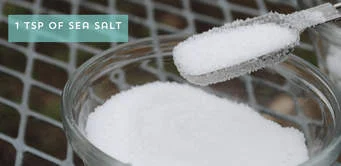Researchers in the United States (US) said the consumption of too much salt may be involved in weight gain.
This is the findings of a new study published in the “The Journal of Clinical Investigation’’.
Traditional thinking has been that salty foods make people drink more water, but the scientists found that it actually reduced thirst and makes people more prone to overeating, weight gain, and even develop metabolic syndrome, which could lead to diabetes and other serious medical conditions.
Previous researches have also associated too much salt with high blood pressure and one way to help control blood pressure is to reduce salt intake.
Considering that people tend to eat more salt than recommended on a daily basis, the research carried out at Vanderbilt University in Teansee in the United States (US) suggested finding ways to cut back on salt.
Highlighting one of the methods to cut back on salt, the National Kidney Foundation suggested limiting prepared foods with a high salt content.
Packaged foods with high salt content include smoked and cured meats, like frankfurters, frozen dinners, canned meals, salted nuts and seeds.
In addition to packaged and deli meats, some canned and frozen foods, from beans to vegetables, can have very high salt levels, “so, always read labels,” the ‘Newsmaxhealth’ reported, adding that foods that may not be associate with being salty could still have sodium in the ingredients.
To this end, consumers were advised to look for no-salt-added brands and when that’s not possible, rinse the food under cold running water to remove as much salt as possible.
The team advised: “When cooking and seasoning foods, replace salt — including garlic salt and onion salt — with herbs and spices.
“Pure granulated garlic and freeze-dried onions should be acceptable alternatives.”
Furthermore, consumers were advised to ask restaurants or the chef to limit the salt in your food and reach for the pepper, not the salt shaker, if a dish needs more seasoning.
This is the findings of a new study published in the “The Journal of Clinical Investigation’’.
Traditional thinking has been that salty foods make people drink more water, but the scientists found that it actually reduced thirst and makes people more prone to overeating, weight gain, and even develop metabolic syndrome, which could lead to diabetes and other serious medical conditions.
Previous researches have also associated too much salt with high blood pressure and one way to help control blood pressure is to reduce salt intake.
Considering that people tend to eat more salt than recommended on a daily basis, the research carried out at Vanderbilt University in Teansee in the United States (US) suggested finding ways to cut back on salt.
Highlighting one of the methods to cut back on salt, the National Kidney Foundation suggested limiting prepared foods with a high salt content.
Packaged foods with high salt content include smoked and cured meats, like frankfurters, frozen dinners, canned meals, salted nuts and seeds.
In addition to packaged and deli meats, some canned and frozen foods, from beans to vegetables, can have very high salt levels, “so, always read labels,” the ‘Newsmaxhealth’ reported, adding that foods that may not be associate with being salty could still have sodium in the ingredients.
To this end, consumers were advised to look for no-salt-added brands and when that’s not possible, rinse the food under cold running water to remove as much salt as possible.
The team advised: “When cooking and seasoning foods, replace salt — including garlic salt and onion salt — with herbs and spices.
“Pure granulated garlic and freeze-dried onions should be acceptable alternatives.”
Furthermore, consumers were advised to ask restaurants or the chef to limit the salt in your food and reach for the pepper, not the salt shaker, if a dish needs more seasoning.






























